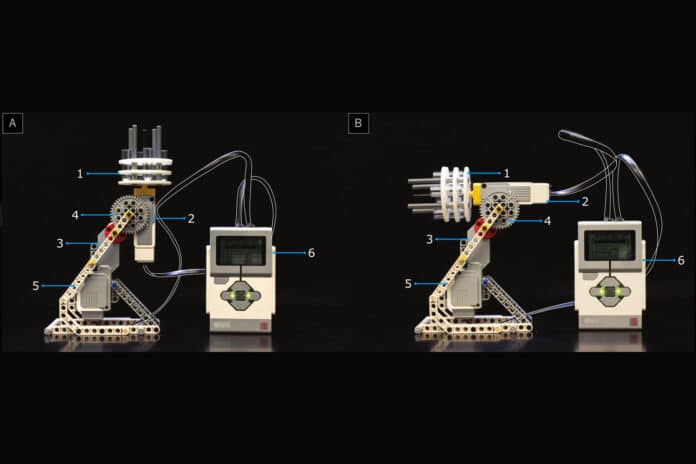Purification of the DNA used in origami is crucial for many fields. DNA origami’s superior positional control also permits the precise patterning of biomolecules and inorganic materials.
Using programmable DNA origami has benefited from electronics, super-resolution imaging, and medicine. Efforts have been put into improving DNA origami assembling. For intricate 3D constructions, the yield of well-folded origami is much lower than 100%.
RZC, or rate-zonal centrifugation, is a contamination-free, high-yield purification technique for Origami DNA. However, because they rely on sluggish passive diffusion, many techniques for producing density gradients take an extended period. In a new study, scientists employed a LEGO gradient mixer to generate rotational motion and quickly produce a quasi-continuous density gradient with a minimum stacking of the viscous material, speeding up the preparation process.
This innovative, inexpensive technique for producing a linear glycerol density gradient sped up diffusion using a straightforward rotational motion. The diffusion process, made possible by the LEGO gradient mixer, takes only one minute in the instrument prototype created from LEGO EV3 Mindstorms components.
Researchers carefully stacked a low-concentration glycerol solution on top of a high-concentration glycerol solution within a centrifuge tube to create the gradient. The program then starts tiling the tubes horizontally and rotating them for 1 minute at low speed (20 rpm) inside the glycerol-filled tubes inserted into the LEGO gradient mixer. The density gradients for the RZC purification are produced as the LEGO gradient mixer stands up again.
The freshly made glycerol gradients are loaded on the DNA origami samples. After that, the tubes are placed inside an ultracentrifuge to purify RZC. Atomic force microscopy (AFM) is used to confirm the purified structures after fractions from the RZC result are taken for AGE analysis.
RZC purification could pave the way for large-scale DNA nanostructure production that will allow the separation of functional DNA nanostructures from the byproducts of bioconjugation reactions, such as extra streptavidin, quantum dots, gold nanoparticles, aptamers, and other moieties. This will be made possible by combining RZC purification with the speed and simplicity of the LEGO gradient mixer.
This technique’s gradient separated molecules in a 1: 2 ratio, separating 6-hb dimer from its precursor and 6-hb monomer from its staple threads. However, the refined dimer only exhibits a 63±6% purity.
Scientists noted, “The gradient created by our LEGO gradient mixer is sufficient to purify folded DNA origami nanostructures from excess staple strands, regardless of their aspect ratios. Moreover, the gradient separated DNA origami dimers from DNA origami monomers. In light of recent advances in large-scale DNA origami production, our method provides an alternative for purifying DNA origami nanostructures in large (gram) quantities in resource-limited settings.”
Journal Reference:
- Sentosa J, Djutanta F, Horne B, Showkeir D, Rezvani R, Leff C, et al. (2023) Gradient-mixing LEGO robots for purifying DNA origami nanostructures of multiple components by rate zonal centrifugation. PLoS ONE 18(7): e0283134. DOI: 10.1371/journal.pone.0283134
